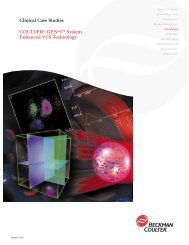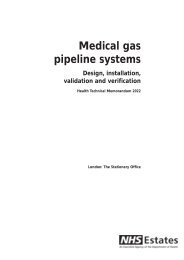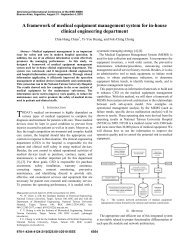Electrosurgery Self-Study Guide
Electrosurgery Self-Study Guide
Electrosurgery Self-Study Guide
You also want an ePaper? Increase the reach of your titles
YUMPU automatically turns print PDFs into web optimized ePapers that Google loves.
<strong>Electrosurgery</strong> <strong>Self</strong>-<strong>Study</strong> <strong>Guide</strong><br />
This increase has brought concerns about monopolar<br />
electrosurgery when used during minimally invasive<br />
procedures. There have been reports of severe illness and<br />
death following laparoscopy where use of electrosurgery<br />
has been implicated as a cause (ECRI, 1995). The hazards<br />
associated with endoscopic electrosurgery use are:<br />
12<br />
• direct coupling<br />
• insulation failure<br />
• capacitive coupling<br />
Each of these can cause severe patient injury if the current<br />
is highly concentrated at the point of contact.<br />
In determining when and how these hazards occur, it is<br />
useful to divide the active electrode and cannula system<br />
into four zones (Figure 19).<br />
One intended<br />
Three unintended<br />
Zone 1 Zone 2 Zone 3 Zone 4<br />
Figure 19 – Four Zones of Injury<br />
Zone 1 is the area at the tip of the active electrode in<br />
view of the surgeon. Zone 2 encompasses the area just<br />
outside the view of the surgeon to the end of the cannula.<br />
Zone 3 is the area of the active electrode covered by the<br />
cannula system. This is also outside the view of the<br />
surgeon. Zone 4 is the portion of the electrode and<br />
cannula that is outside the patient’s body. The greatest<br />
concern is the unseen incidence of stray electrosurgery<br />
current in Zones 2 and 3 (Harrell, 1998).<br />
Direct coupling occurs when the active electrode is<br />
activated in close proximity or direct contact with other<br />
conductive instruments within the body. This can occur<br />
within Zones 1, 2, or 3. If it occurs outside the field of<br />
vision and the current is sufficiently concentrated a patient<br />
injury can occur.<br />
Insulation failure occurs when the coating that is applied<br />
to insulate the active electrode is compromised. This can<br />
happen in multiple ways that range from repeated uses to<br />
rough handling to using very high voltage current. There is<br />
also concern that some active electrodes may not meet<br />
the standards for electrosurgical devices set by the<br />
Association for the Advancement of Medical<br />
Instrumentation (AAMI), and the American National<br />
Standards Institute (ANSI). Insulation failure that occurs<br />
in Zones 2 or 3 could escape detection by the surgeon<br />
and cause injury to adjacent body structures if the current<br />
is concentrated (Figure 20).<br />
Figure 20 – Insulation Failure<br />
Capacitive coupling is the least understood of the<br />
endoscopic electrosurgical hazards. Anytime two<br />
conductors are separated by an insulator a capacitor is<br />
created. For example, a capacitor is created by inserting<br />
an active electrode, surrounded by its insulation, down a<br />
metal cannula (Figure 21).<br />
Abdominal Wall<br />
Laparoscopic View<br />
Conductor<br />
(Electrode Tip)<br />
Insulator<br />
(Electrode Insulation)<br />
Conductor<br />
(Metal Cannula)<br />
Figure 21 – Instrument/Metal Cannula Configuration<br />
Capacitively coupled electrical current can be transferred<br />
from the active electrode, through intact insulation and<br />
into the conductive metal cannula. Should the cannula<br />
then come in contact with body structures, that energy<br />
can be discharged into these structures and damage them<br />
(Harrell). With an all-metal cannula, electrical energy<br />
stored in the cannula will tend to disperse into the patient<br />
through the relatively large contact area between the<br />
cannula and the body wall. Because the contact area is<br />
relatively large, the electrical energy is less concentrated<br />
and less dangerous. For this reason it is unwise to use










